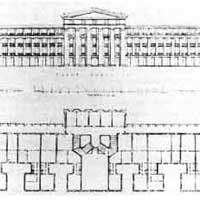Simutopia
Michael O'Malley, Associate Professor of History and Art History, and Paula Petrik, Professor of History and Art History, George Mason University
Assignment
Background
Other notable communities included the socialist utopias founded by followers of Robert Owen and Charles Fourier. Owen, a wealthy English textile manufacturer, hoped to form communities where all would share equally in the production process and all would own the machines together. He proposed to "cut the world up into villages of three hundred to two thousand souls; allot each person an area of land varying from one-half an acre to one and a half acres; place the dwellings of each village in the form of a parallelogram with common kitchens, eating apartments, schools and places of worship in the center; require every person to forswear individualism and work for the common benefit." =Owen's son, who later served in Congress, called collective communities "the invention which will at once multiply the physical and mental powers of the whole society to an incalculable extent." Owen tried to realize his dreams by buying the town of New Harmony, Indiana and reorganizing it as a socialist collective. a drawing of the plan for New Harmony appears above. Owen's "harmonists" dislaced an earlier generation of utopians, the Rappites, who had founded Harmony Indiana as a religious utopia. A history of New Harmony appears here.
Frenchman Charles Fourier similarly argued that utopain collectives could revolutionize human life, Albert Brisbane, the leading Fourierist in America, argued that planned, collectivist communities would do for the household "what the mariners compass has done for navigators, the telescope for astronomy, and steam for machinery." Fourierist's organized themselves into "phalanxes," in which property would be commonly owned and all work shared in turn. Fourierist ideas also served as the basis for the famous "Brook Farm" collective intellectual experiment, which included such major literary figures as Hawthorne, Melville, Emerson, Thoreau, and Louisa May Alcott. Below is a plan for the "phalanstery" to house community members at Red Bank, New Jersey. A more modest building was eventually constructed. Although all Fourierist communities failed, they were surprisingly popular. Phalanxes were established at communities as diverse as Red Bank, New Jersey, Ripon, Wisconsin, and Dallas, Texas. Click here for an excellent review of Fourier's ideas.

Task
In this assignment you will draw your own utopia at addresses the historical problems of the Jacksonian era.
Before you begin, ask yourself this: What historical problems facing Americans in the Jacksonian era does this community solve? How does it solves them? Why would an American man or woman of the period want to live in your utopia?
You might consider the following possibilities.
Will your utopia be:
A religious community, where all share the same beliefs? What will those
beliefs be?
A socialist community, with all property owned in common and all work
shared equally?
A combination of both?
Will it be purely a commercial enterprise, designed to make money? Or a non profit experiment? Or an experiment in radical equality?
Your community must be abe to support itself—will it be agricultural, industrial, or a mix of both?
Will it be closed to the rest of the world, or open?
Will it be rural in character, or urban?
Will there be slavery?
Go to the Simutopia exercise and construct your utopia. This link will open a new window.
Last Updated | April 2004
